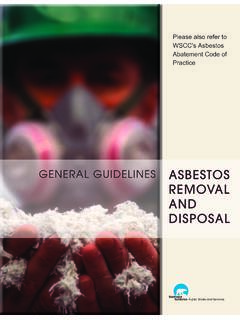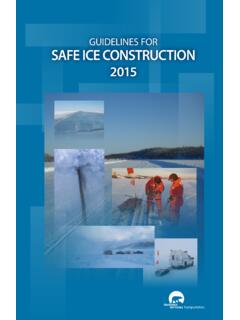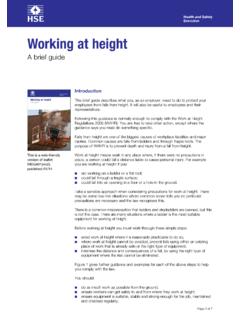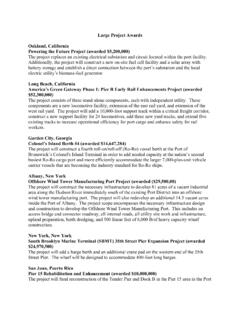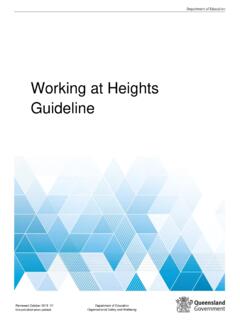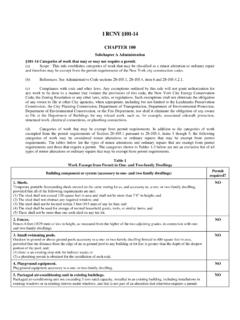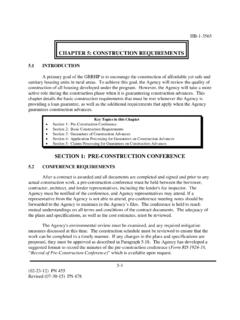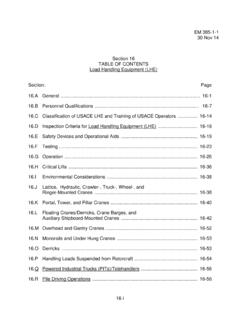Transcription of Roof Inspection Checklist - Gov
1 roof Inspection Checklist for Assets Maintained and Operated by Public Works and Services (GNWT) BACKGROUND roof systems can deteriorate from: normal wear; severe weather conditions ( , wind and snow loads); building movement ( , settlement, material contraction/ expansion); and improper design, construction and maintenance. Any roof repairs not dealt with after the first signs of failure can result in increased damage to the building envelope and interior finishes, and loss of occupant productivity, if damage causes interruption in client services and program delivery.
2 Failure of structural integrity can endanger occupant safety. PURPOSE Regular Inspection of building roof systems will lead to early detection of roof problems, protection of Government capital assets, and maintenance of safe working environments for building occupants. OBJECTIVES To determine if the roof system is performing according to its intended function. To identify signs of weakness, deterioration or hazard. To identify needed repairs. GENERAL APPROACH Inspect exterior for: continuity of roof covering; deterioration of fascias, gutters and soffits; and performance of flashings.
3 Inspect interior finishes (ceilings and walls) for signs of water penetration, frost buildup and structural distress. Record and report Inspection findings. Initiate maintenance and repair projects. Report any unsafe working conditions or potential system failures immediately to the PW&S Regional Superintendent. PROCESS Regional maintenance personnel are to: Perform annual formal visual roof inspections when roofs are free of snow and materials, and informal inspections after every severe wind or rain condition. Review, learn and follow roof safety procedures, including those in the Fall Prevention and roof Safety pamphlet; learn about problem roof conditions and terminologies.
4 Before performing a roof Inspection , review: past Inspection reports and photographs; construction documents; particulars of any repair/maintenance/ replacement, and the most current roof Snow Overload Risk Assessment Checklist . Include non-destructive investigation ( , infrared thermography) if moisture infiltration is suspected. Obtain approval of PW&S Regional Superintendent prior to any demolition detection work on any wall, ceiling, or roof cavity. Include photographs and test data in the report, so that changes in roof condition can be verified, and so that a historic record of roof condition is available to future inspectors.
5 Keep and maintain records of all: inspections (including this Checklist ); test investigations (thermographic readings); and roofing repairs and replacements. Develop a maintenance workplan to correct deficient conditions in a timely manner. Monitor the snow loading on roofs. When the snow loading on High Risk Roofs exceeds the usual winter accumulation, steps are to be taken to remove the excess snow. Inform the PW&S Regional Superintendent when usual winter snow accumulations are exceeded on High Risk Roofs. Removal of snow must be done in such a manner as to ensure the safety of maintenance personnel and minimize damage to the roof structure and membrane.
6 PUBLIC WORKS AND SERVICES MMS-427 2 Inspection Checklist General roof Conditions Item Remarks Debris on roof Drainage Physical Damage Attic Conditions Structural Deformation Other Flat / Membrane roof Item Remarks Condition of Coating Granular Loss Punctures Cracks / Alligatoring Blisters / Fishmouths Ponding Other Sloped roof Item Remarks roof Material Condition of Surface Deformed Edges Shingle: Buckled Curled Missing Tabs Granular Loss Other Metal: Corrosion Fasteners Other roof Features Item Remarks Fascia Soffit Flashing Gutters / Drains, etc.
7 Skylights Chimneys / Vents Fall Arrest Anchors Control Zone Access Drains / Vents Other Ceiling Conditions Item Remarks Cracks Water Staining Water Leaks Seasonal Change Other Exterior Wall Surfaces Item Remarks Deformed Finish Surface Deterioration Staining Other Interior Wall Surfaces Item Remarks Cracks Water Staining Water Leaks Deformed Finish Seasonal Change Window Leaks Door/Window Alignment Other Summary/Comments (Highlight areas of concern and any rapid degradation in roof system) roof INSPECTIONS roof INSPECTIONSOCCUPANT RESPONSIBILITIES Immediately report signs of envelope movement, and degradation, especially after extreme weather conditions.
8 Immediately report signs of roof damage, structural anomalies and/or leaks to PW&S Regional maintenance personnel. Coordinate impacts on facility program activities, once PW&S regional maintenance staff informs occupants about planned roof Inspection , maintenance and repair programs. roof PLAN AND DETAILS3 Comment on changes from previous inspections, and overall roof condition. Indicate recommended action of roof repair and/or further assessment, and estimated remaining life expectancy of roof system. Include any photographs and thermography records in this report.
9 USE THIS AREA ONLY IF DEFICIENCIES ARE OBSERVED. Sketch roof plan. Include north arrow, the location of the items listed below, approximate dimensions of building, roofing materials, and other relevant items located on the roof . Show changes in roof elevations in a separate sketch. Identification Code A Access Hatch E Expansion Joint Cover R roof Vent V Vent Pipe B Base Flashing F Fascia and Gravel Stop U HVAC Unit L Ladder C Cap Flashing G Gutter System J Flag Pole S Skylight D roof Drain H Vent / Fan Hood W Ponded Water T Walkway K Chimney P Parapet or Fire Wall PWS RESPONSIBILITIES Develop and implement a maintenance program, including using the roof Inspection Checklist .
10 Perform annual visual roof inspections for all GNWT operated facilities, and complete a report based on the Checklist . Interview occupants concerning building performance. Recommend actions to repair unsatisfactory conditions, including developing a maintenance workplan based on the urgency of required upgrades. Maintain a history of roof Inspection reports for each GNWT owned/operated facility at the Regional PW&S office in order to monitor changes in roof system performance. Report rapidly deteriorating roofs and/or water damage to the PW&S Regional Superintendent.

